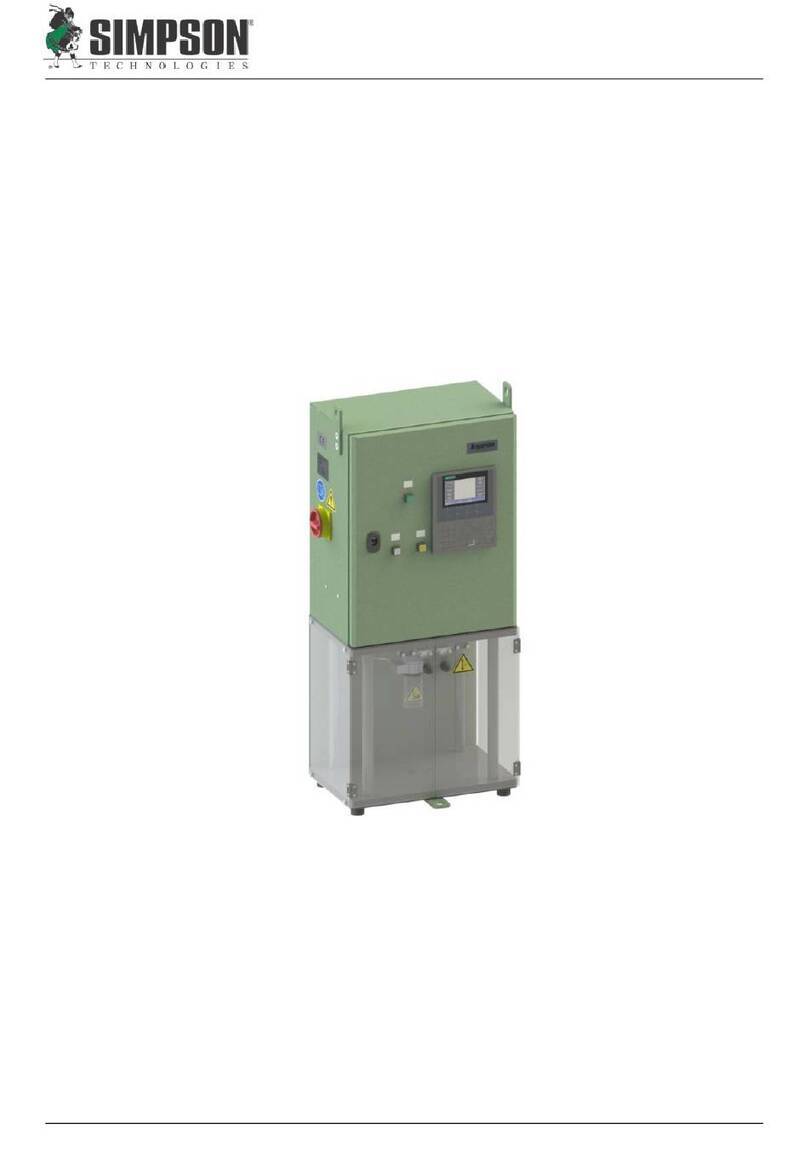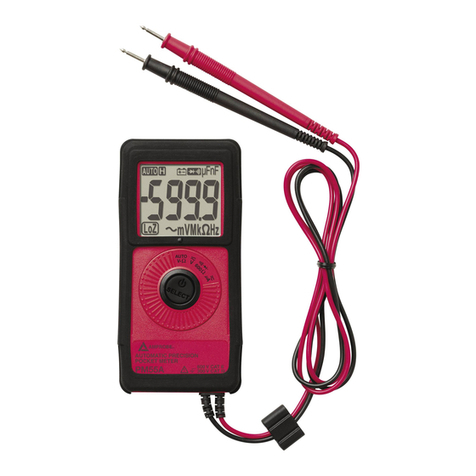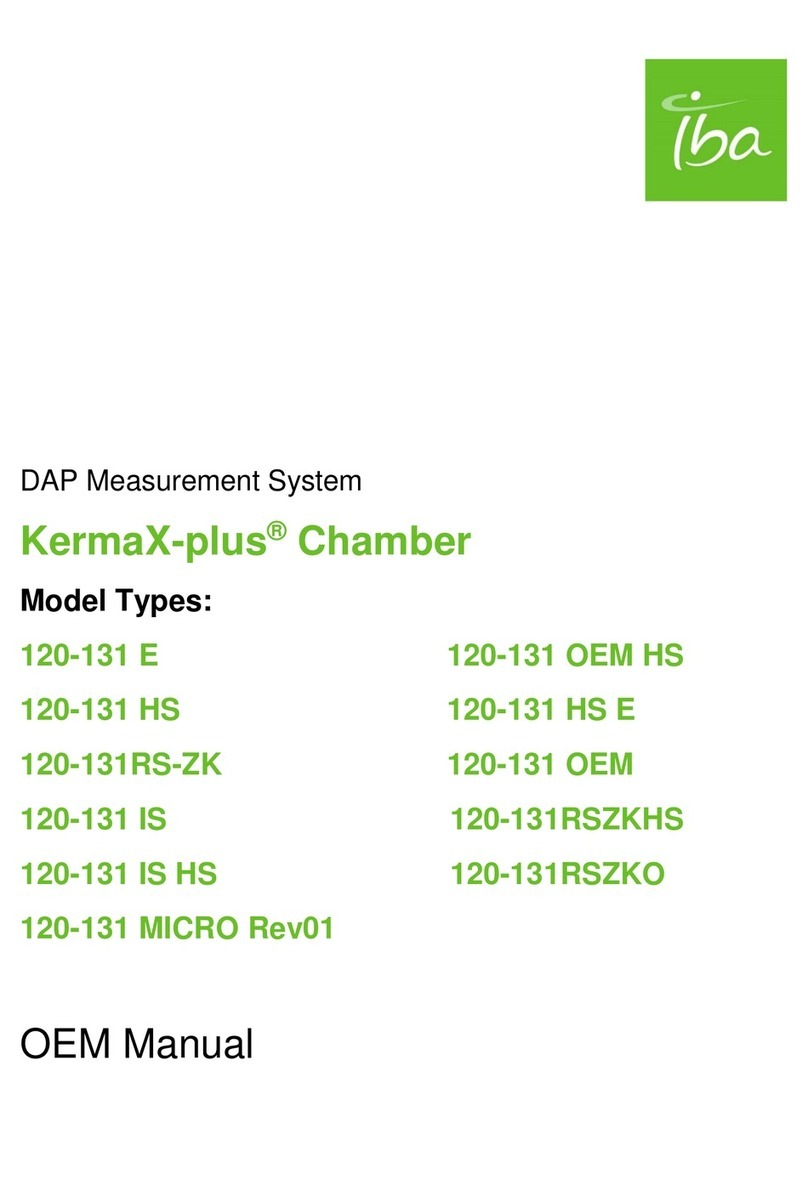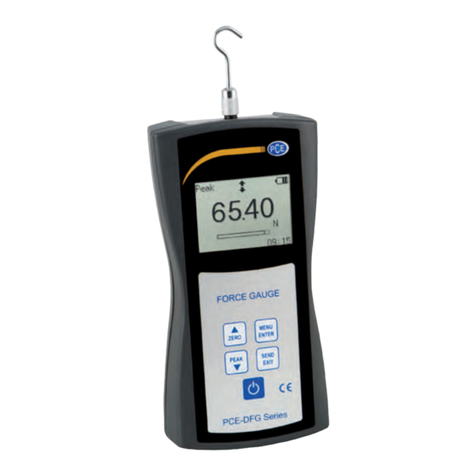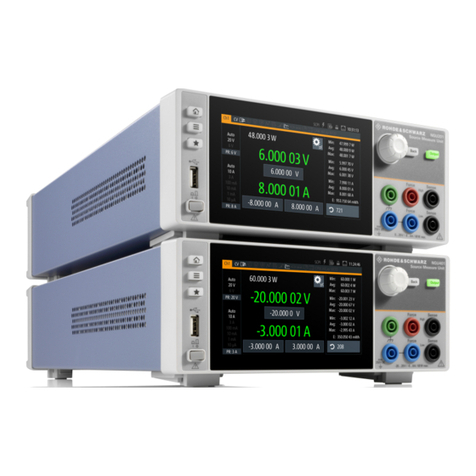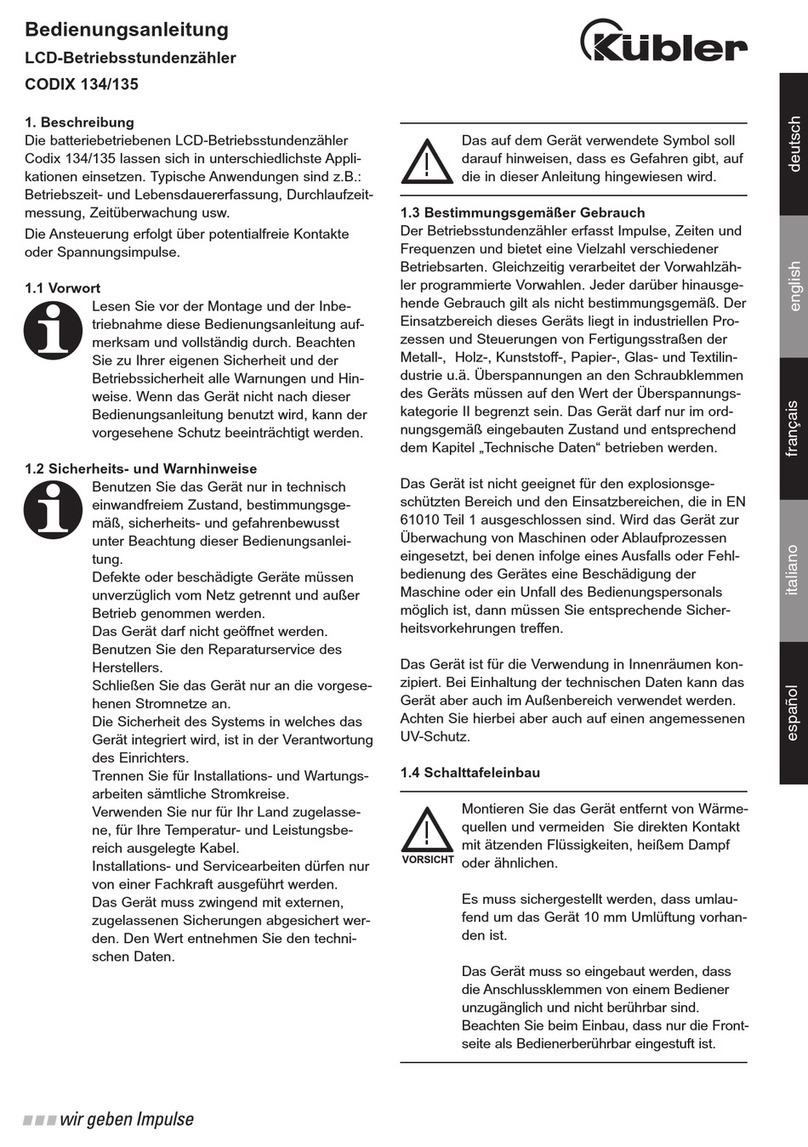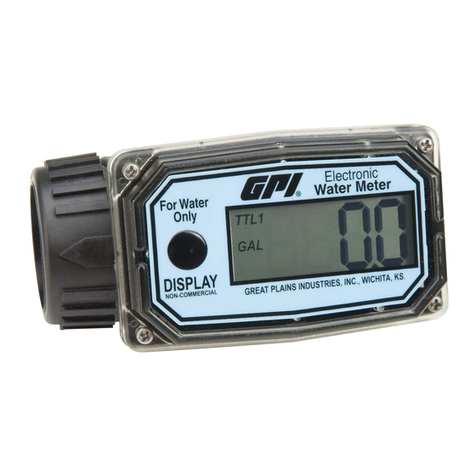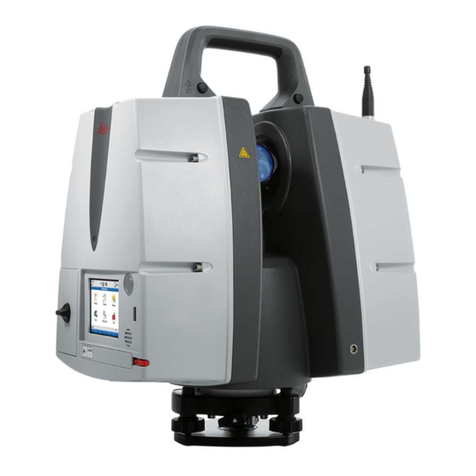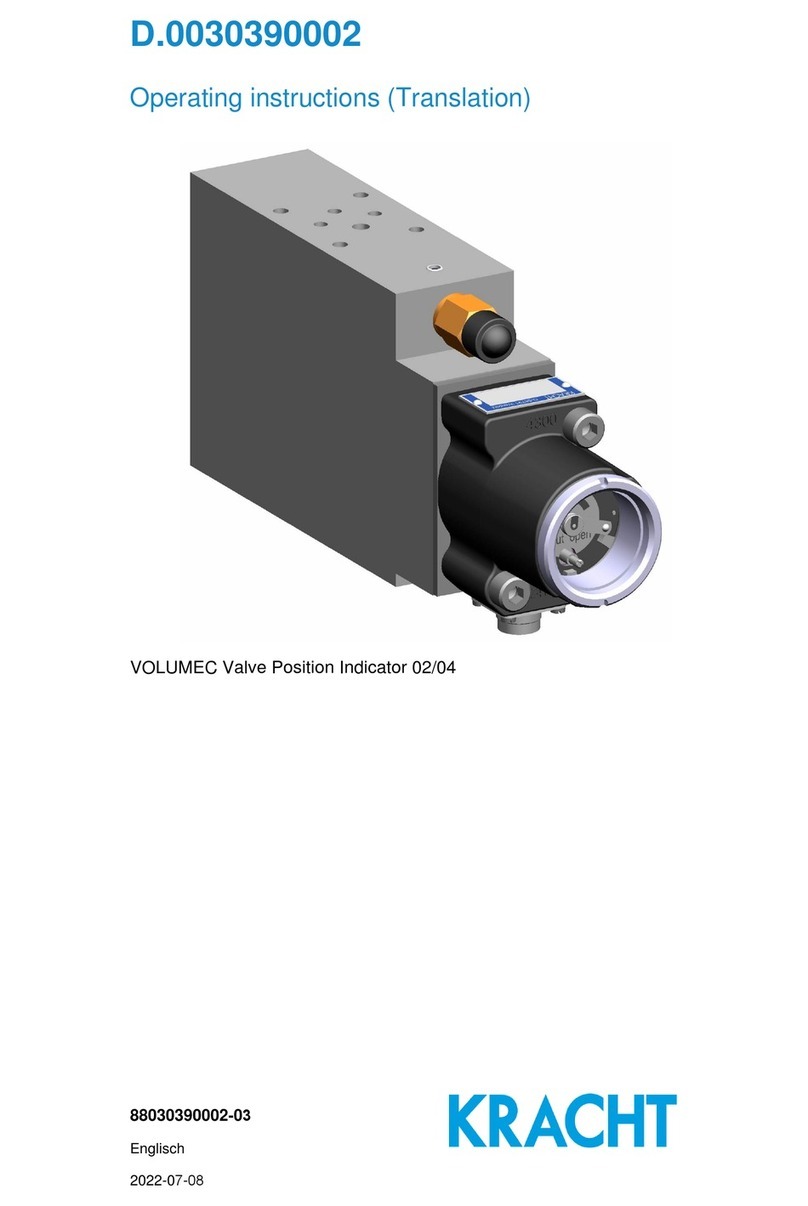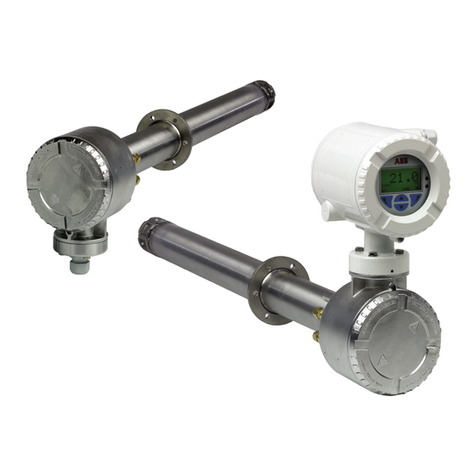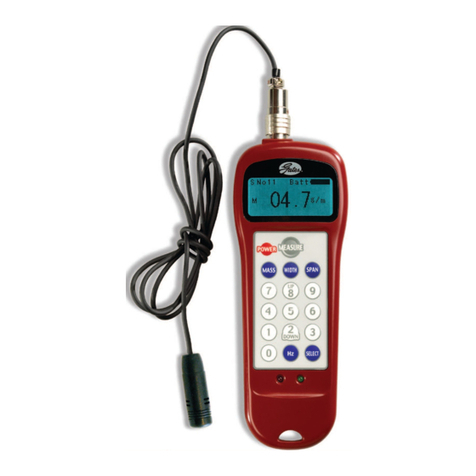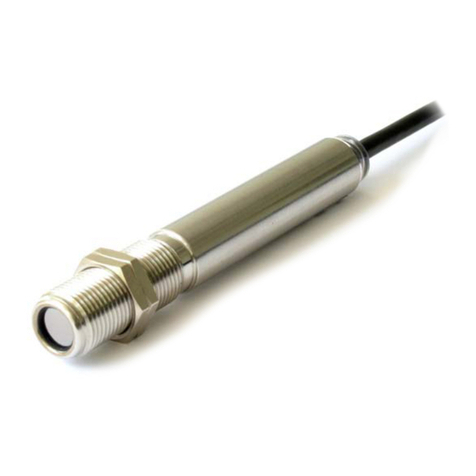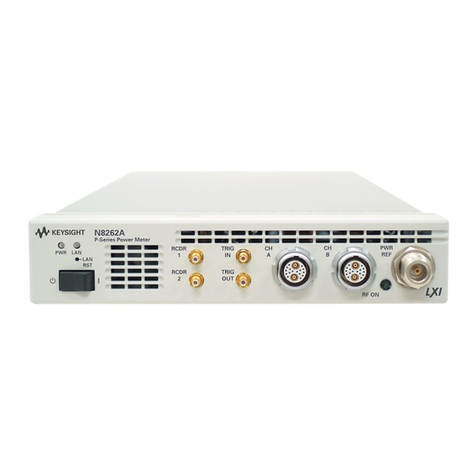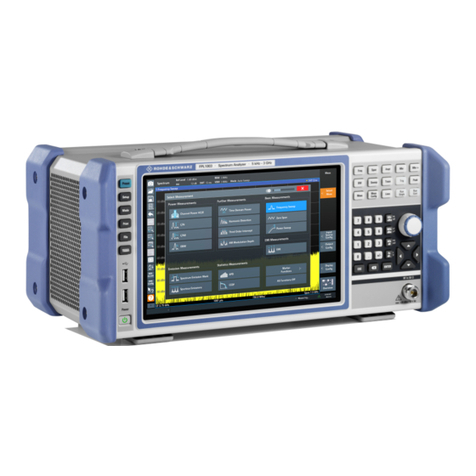Tecfluid AD Series User manual

R-MI-AD15 Rev.: 3 English version
Serie AD
Flow switch and indicator
Instructions manual
The art of measuring

2
Thank you for choosing a product from Tecfluid S.A.
This instruction manual allows the installation, configuration,
programming and maintenance. It is recommended to read it before
using the equipment.
• This document shall not be copied or disclosed in whole or in any
part by any means, without the written permission of Tecfluid S.A.
• Tecfluid S.A. reserve the right to make changes as deemed
necessary at any time and without notice, in order to improve the
quality and safety, with no obligation to update this manual.
• Make sure this manual goes to the end user.
• Keep this manual in a place where you can find it when you need
it.
• In case of loss, ask for a new manual or download it directly from
our website www.tecfluid.com Downloads section.
• Any deviation from the procedures described in this instruction
manual, may cause user safety risks, damage of the unit or cause
errors in the equipment performance.
• Do not modify the equipment without permission. Tecfluid S.A. are
not responsible for any problems caused by a change not
allowed. If you need to modify the equipment for any reason,
PREFACE
WARNINGS

3
TABLE OF CONTENTS
SERIES AD
1 INTRODUCTION ........................................................................... 5
2 WORKING PRINCIPLE ................................................................... 5
3 RECEPTION .................................................................................. 7
4 INSTALLATION ............................................................................. 7
1A / 2A LIMIT SWITCH
5 INTRODUCTION ........................................................................... 8
5.1 Set point adjusment ............................................................ 8
5.2 Electrical connection ........................................................... 9
AMD LIMIT SWITCH
6 INTRODUCTION ........................................................................... 10
7 OPERATION ................................................................................. 10
8 MOUNTING THE LIMIT SWITCH IN AN EXISTING EQUIPMENT ....... 11
8.1 Kit contents ......................................................................... 11
8.2 Preparing the kit ................................................................. 11
8.3 Assembling the AMD kit ...................................................... 12
8.4 Switching point adjustment ................................................. 13
8.5 Electrical connection ........................................................... 14
8.6 Mounting ........................................................................... 14
9 ELECTRICAL CONNECTION .......................................................... 14
TH6 TRANSMITTERS
10 INTRODUCTION ........................................................................... 15
11 MODELS ...................................................................................... 15
11.1 TH6 ................................................................................... 15
11.2 TH6H ................................................................................. 15
12 ELECTRICAL CONNECTION .......................................................... 15
12.1 Power supply and analog output ......................................... 16
13 4-WIRE CONNECTION .................................................................. 16
14 HART TRANSMITTERS ................................................................. 17
14.1 Additional functions with HART communication .................... 17
14.2 HART communication characteristics ................................... 17

4
15 ”WRITE PROTECT” ....................................................................... 18
16 MAINTENANCE ............................................................................ 19
16.1 Series AD .......................................................................... 19
16.2 Potential problems with the indicator housing ........................ 19
16.2.1 The indicator pointer rubs on the reading scale ......... 19
16.2.2 Deviation of the zero on the scale ............................ 19
16.3 AMD limit switch maintenance ............................................. 20
16.3.1 Electrical verification ................................................ 20
16.4 TH6 transmitter maintenance ............................................. 20
17 TECHNICAL CHARACTERISTICS ................................................... 21
17.1 Series AD ........................................................................... 21
17.2 1A / 2A limit switch ............................................................. 21
17.3 AMD limit switch ................................................................. 21
17.4 TH6 transmitter .................................................................. 21
17.4.1 Power supply .......................................................... 21
17.4.2 Outputs .................................................................. 21
17.4.3 General characteristics ............................................ 21
18 SAFETY INSTRUCTIONS ............................................................... 22
18.1 Pressure equipment directive .............................................. 22
18.2 Certificate of conformity TR CU (EAC marking) ..................... 22
19 ADDITIONAL INSTRUCTIONS FOR THE ATEX VERSION ................. 23
19.1 Non-metallic parts .............................................................. 23
19.2 Connecting conductive parts to earth .................................. 23
19.3 AMD limit switch ................................................................. .24
19.4 TH6 transmitters ................................................................. 24
19.5 Marking .............................................................................. 25
20 FLOW RANGES ............................................................................ 25
21 DIMENSIONS ............................................................................... 26
22 ATEX CERTIFICATE ...................................................................... 28
23 DECLARATIONS OF CONFORMITY ACCORDING TO ATEX ............ 31

5
SERIES AD
1 INTRODUCTION
The series AD of flow switches and indicators are flowmeters for liquids and gases.
They are very robust instruments prepared to work under extreme conditions.
They can fit local flow rate indication by means of magnetic coupling, with scales calibrated
in l/h, m3/h, kg/h, t/h, %, etc.
They can fit switches or electronic transmitters that allow to detect a specific flow rate and
provide a flow rate signal to a remote device.
2 WORKING PRINCIPLE
A spring C keeps a calibrated disc B at rest. When a fluid flows at a certain velocity, it
pushes the disc B, forcing its displacement to an equilibrium point.
The distance covered by B depends on:
•The force of the fluid flow F.
•The ratio of the areas A and B.
•The opposing force of the spring C.
The equilibrium between the forces F and that generated by C defines the position of the
calibrated disc B, equivalent to the flow rate.
The calibrated disc B has a magnet M. The magnetic field acts on the limit switches and/or
the local indicator.

6
The ADI15 model fits a magnetic flow indicator system using a pointer on a graduated scale.
It can also fit the same limit switches as in AD15 model as well as the AMD inductive limit
switches.
The AD15 model fits 1 or 2 reed based limit switches.
BSP NPT
BSP NPT

7
3 RECEPTION
The series AD flowmeters are supplied conveniently packaged for their protection during
transportation and storage, together with their instructions manual for installation and
operation.
The instruments are supplied tested in our calibration rigs, ready for installation and service.
Before installing the flowmeter, remove all the blocking elements.
For models ADI, with the instrument in its working position, move the disc and check that
the indicating needle moves all over the scale and returns to zero.
4 INSTALLATION
If the flow switch model is AD15, it should be installed in a pipe so that the arrow on the label
points towards the fluid direction.
If it is an ADI15 model, the flow direction should coincide with that indicated on the scale.
The four possible positions are:

8
The "0" on the scale indicates the fluid inlet on the meter, and the end of the scale indicates
the fluid outlet.
1A / 2A LIMIT SWITCH
5 INTRODUCTION
It is a SPDT reed type switch that is used to generate an alarm or an operation when the
circulating flow reaches a certain value.
It consists of a bistable reed sensor (SPDT), in other words, when the flow exceeds the set
point the sensor changes its state and maintains it until the flow decreases below that value.
In the same instrument, there may be one or two sensors, depending on the points to be
detected.
5.1 Set point adjustment
The switch housing has a mark on the side next to the graduated scale. The position of this
mark indicates the value at which the switch will be activated.
To adjust the position, loosen the fixing screw and slide the switch through the slot until the
set point coincides with the desired flow rate on the scale.
Fixing
screw
Switching
mark

9
5.2 Electrical connection
For the electrical installation, a multi-conductor cable should be used to obtain a good seal
with the cable gland. The connector is provided with a PG 7 cable gland, suitable for a 4.5
to 7 mm outside diameter cable.
Terminal 1: Common
Terminal 2: Normally open (NO)
Terminal 3: Normally closed (NC)
Earth terminal: Not connected
conexión
The electrical installation should provide a fuse or circuit breaker to protect the reed switch
from overloads.
When installing the connector, make sure that the cable gland closes over the cable and that
the connector with the rubber seal is well screwed down to maintain its IP rating.
Make sure that the contact rating is not exceeded (see section 17.2 in page 21). If high loads
are to be switched, use an auxiliary relay.
When using inductive loads, such as relays or electro-valve coils, surge arresters should be
installed to protect the reed contacts (VDR in case of AC supply and free willing diodes in
case of DC supply).

10
AMD LIMIT SWITCH
6 INTRODUCTION
The AMD limit switch can be used to generate an alarm or an operation when the flow rate
that the instrument is measuring reaches a preset value on the scale plate.
The AMD limit switch consists of a NAMUR slot type inductive sensor, that is actuated by a
vane. Given that there is no physical contact in the operation, the limit switch has no influence
on the indicator needle movement.
An instrument can be equipped with one or two sensors, depending on the number of points
to be detected. A NAMUR amplifier with a relay output can be supplied as an option.
7 OPERATION
The indicator needle moves together with the vane mounted on its shaft. When the vane
enters into the slot of the sensor, the limit switch changes its state.
The sensor is mounted on a support which includes a needle that indicates the switching
position. The needle, that is below the scale plate, can be seen through the scale slot.
Switching
points

11
8 MOUNTING THE LIMIT SWITCH IN AN EXISTING EQUIPMENT
When the AMD limit switch is to be fitted to an existing device, please follow these steps.
8.1 Kit contents
The kit contains the following elements:
In the kits, the gaskets (5) and the blanking plugs (7) are not provided as loose parts. They
are incorporated in the cable glands (6).
8.2 Preparing the kit
Remove the cover, unscrewing the four screws M4.
Slide the scale plate in the direction indicated in the figure, until it is released from the slot.
Ensure that the rings (5) are placed in the thread of the gland (6). If not, they should be
placed. Remove the plugs from the indicator box with a flat screwdriver and replace them by
the two cable glands.
The cable glands that are not expected to be used should be left with the blanking plug (7)
placed to preserve watertight.
AMD kit
Quantity Material Position
1 AMD limit switch circuit 1
2 Self tapping screw DIN7982 B-2,2 x 9,5 Nº2 A2 2
1 AMD vane 3
1 Self tapping screw DIN7982 B-2,2 x 9,5 Nº2 A2 4
2 Gasket 5
2 Cable gland IP68 6
2 Cable gland blanking plug 7
Blanking plug (7) Cable gland (6)

12
8.3 Assembling the AMD kit
Slide the circuit (1) into the slot until it stops, and then screw it as shown in the figure.
Place the vane (3) in the position shown in the figure. The height on the shaft should be such
that when the vane passes through the sensor slots, remains centered without touching
them. Tighten the screw (4) holding the vane against the shaft.
Slot
Screw (2)
Screw (2)
Vane (3)

13
8.4 Switching point adjustment
At the bottom of the switching needle, the fixing nuts of the switching points can be found.
To move the switching point, the fixing nuts have to be slightly loosen without removing the
scale plate (see figure on the next page). After that, place the switching point at the required
scale value, and fix it with the nuts.
As standard, when the instrument has only one AMD, it is configured as a minimum limit
switch.
Switching needles
Switching needles
Fixing nuts
Fixing nuts

14
8.5 Electrical connection
Proceed according to section 9.
8.6 Mounting
Slide the scale plate into the slot until it stops as shown in the figure. Mount the cover with
the four screws M4.
9 ELECTRICAL CONNECTION
For the electrical connection, the instrument is provided with a four terminal connector.
For the electrical installation it is recommended to use multiple conductor cables with
sections of 0.25 or 0.5 mm2, in order to make it easier to connect.
Before starting the installation, check that the cable glands are the right size for the cables to
be used, this will guarantee the instrument will stay watertight. The M12x1.5 cable glands
used are for cables with outside diameters between 2.5 mm and 6.5 mm.
Peel the outside insulation to free the inner cables. It is recommended to tin the ends of the
wires to avoid loose ends. Pass the cables through the cable glands and screw down in the
corresponding positions of the terminal strip. Once the wiring is finished make sure that the
cables are well gripped by the cable glands to maintain the degree of protection.
The cable glands must be always closed. Entry of dust or some types of vapours can
damage the internal system of bearings and therefore the equipment.
To gain access to the terminal block, the scale plate must be removed. To do this, slide it to
the left through the slot until released.
The numeration of the terminals is the following:
Limit switch 2
(maximum)
Limit switch 1
(minimum)

15
TH6 TRANSMITTERS
10 INTRODUCTION
Transmitters TH6 are electronic position transducers with a microprocessor. The instrument
uses the Hall effect to capture the field of a magnet. This signal, after the microcontroller
processing, is converted into a current signal of 4-20 mA in a 2-wire loop. This signal is
proportional to the flow rate.
11 MODELS
11.1 TH6
It is a 4 to 20 mA transmitter proportional to flow rate. 4 mA corresponds to beginning of the
scale. 20 mA corresponds to full scale. Between the beginning of the scale and the first point
of the scale the analog output is constant at 4 mA, to avoid false readings of flow rate.
11.2 TH6H
It is a TH6 transmitter that incorporates HART TM protocol compatibility. With this protocol the
user can change the measuring range of the 4-20 mA loop, and data like flow rate, with its
associated measuring units.
12 ELECTRICAL CONNECTION
For the electrical connection, the transmitter has two screw terminals.
For the electrical installation it is recommended to use multiple conductor cables with
individual cable sections in the order of 0.25 to 0.5 mm2in order to make it easier to
connect.
A twisted pair wiring should be used to avoid electrical interferences in the 4-20 mA loop. In
some instances, shielded cable may be necessary.
Before starting the installation, check that the cable glands are the right size for the cables to
be used, this will guarantee the instrument will stay watertight. The M12x1.5 cable glands
used are for cables with outside diameters between 2.5 mm and 6.5 mm.
Peel the outside insulation to free the inner cables. It is recommended to tin the ends of the
wires to avoid loose ends. Pass the cables through the cable glands and screw down in the
corresponding positions of the terminal strip. Once the wiring is finished make sure that the
cables are well gripped by the cable glands to maintain the degree of protection.
The cable glands must be always closed. Entry of dust or some types of vapours can
damage the internal system of bearings and therefore the equipment.
To help in the wiring of the equipment, the description of the terminals is marked on the
printed circuit next to the terminal strip.
Before connecting the power supply, you must be sure that the supply voltage is the correct
for the installation. The power supply voltage is indicated on the label of the transmitter.

16
12.1 Power supply and analog output
The connection is made in the terminal block. The positive terminal of the power supply is
connected to the position + and the positive terminal of the load in the position -. The
negative terminals of the power supply and the load are connected together. The instrument
works in a 2-wire system, that is, the supply and signal line is the same. It is recommended
to use a twisted pair wiring or shielded cable to avoid interferences in the current loop.
13 4-WIRE CONNECTION
If Direct Current power supply for the transmitter is not available in the installation, it will be
necessary to incorporate an additional power supply as in the following figure.
Power
supply
12 to 36 VDC

17
14 HART TRANSMITTERS
The TH6H transmitters have a modem for HART communication.
TH6H transmitters are fully compatible with the HART Server software from HART
Communication Foundation.
Tecfluid S.A. do not guarantee that the TH6H transmitter is compatible with the different
servers on the market.
When connecting the transmitter, an external resistor (R ext.) should be included. Its
minimum value needs to be 200 Ω, and the maximum value depends on the power supply
as follows:
In this case the power supply voltage needs to be 18 VDC minimum.
In order to establish HART communication, it is necessary to connect a terminal or PC with a
HART modem, in one of the points indicated in the following figure.
14.1 Additional functions with HART communication
By means of the implemented commands, the user can obtain the following information:
• Flow rate value in the scale units
• Totalizer value (even if the equipment does not have a display).
• Reset or writing of a totalizer value.
• Change of beginning and end of scale of the current loop.
• Possibility of writing tags and messages into the instrument.
14.2 HART communication characteristics
The detail of the characteristics with respect to the HART communication are available in the
corresponding “Field Device Specification” document.
Possible points of connection of a HART
terminal or a PC with a HART modem

18
Summary of the main communication characteristics:
Manufacturer, Model and Revision Tecfluid S.A., TH6H, Rev. 0
Device type Transmitter
HART revision 6.0
Device Description available No
Number and type of sensors 1
Number and type of actuators 0
Number and type of host side signals 1, 4 – 20 mA analog
Number of Device Variables 2
Number of Dynamic Variables 1
Mappable Dynamic Variables No
Number of Common Practice Commands 5
Number of Device Specific Commands 0
Bits of Additional Device Status 12
Alternative working modes? No
Burst mode? No
Write Protection? Yes
Electrical characteristics referred to the analog loop and communications:
Reception impedance:
Rx > 3,3 M
Cx < 1000 pF
15 “WRITE PROTECT”
The instrument has a jumper that can be used to avoid changes in the configuration. When
the jumper is connected the instrument can be configured via HART. When the jumper is
removed, “Write Protect” is activated for HART, thus avoiding any changes in the
configuration.

19
16 MAINTENANCE
16.1 Series AD
No special maintenance is required.
16.2 Potential problems with the indicator housing
16.2.1 The indicator pointer rubs on the reading scale
To remove the cover (6), remove the four screws M4 at the corners of the indicator housing.
Rubbing normally happens if the meter has been hit or dropped. Simply straighten the
pointer (2) by bending it slightly until it is separated between 2-3 mm from the reading scale
surface (5)
16.2.2 Deviation of the zero on the scale
When the indicator pointer (2) does not point zero in its rest position, place the flowmeter in
its real working position on top of a non-magnetic table. If when the float is moved the
pointer moves but does not return to 0, check that the pointer hub (3) is firmly attached to
the pointer shaft (1). If it isn’t, secure the pointer hub (3) onto the conical tip (1) of the shaft
by tapping it lightly and carefully.
If the pointer hub is fixed, make the indicator pointer coincide with the 0 on the scale using
the frontal adjusting screw (4) on the indicator pointer. Make sure that the shaft (1) is held
fast so as not to be bent or damaged
Check that there is no rubbing between the pointer movement system and the cables
connected to a limit switch or transmitter.

20
16.3 AMD limit switch maintenance
16.3.1 Electrical verification
Check that the voltage at the terminals + and - is over 7.5 V when the vane is in the slot.
Connect a multimeter with the scale in DC mA, in series with the terminal +.
Verify that the current is less than 1 mA when the vane is into the slot and more than 3 mA
when the vane is out of the slot.
The verification can be done with the following circuit diagram:
Without the sensor, the operation of the amplifier can be checked using the following circuit
diagram:
With the potentiometer the current through the NAMUR amplifier can be modified. The
switching point must be between 1.2 mA and 2.1 mA. That is, with the current below 1.2
mA the output relay must have a state and above 2.1 mA the output relay must have the
other state.
16.4 TH6 transmitter maintenance
No special maintenance is required.
9V battery
(nominal 8.2V
for NAMUR)
NAMUR
amplifier
Potentiometer
This manual suits for next models
2
Table of contents
Other Tecfluid Measuring Instrument manuals

Tecfluid
Tecfluid Series LT User manual
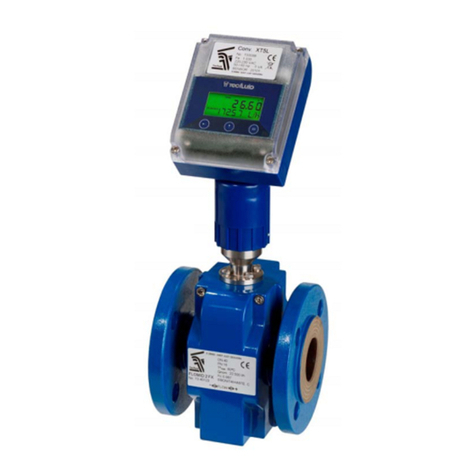
Tecfluid
Tecfluid FLOMID Series User manual
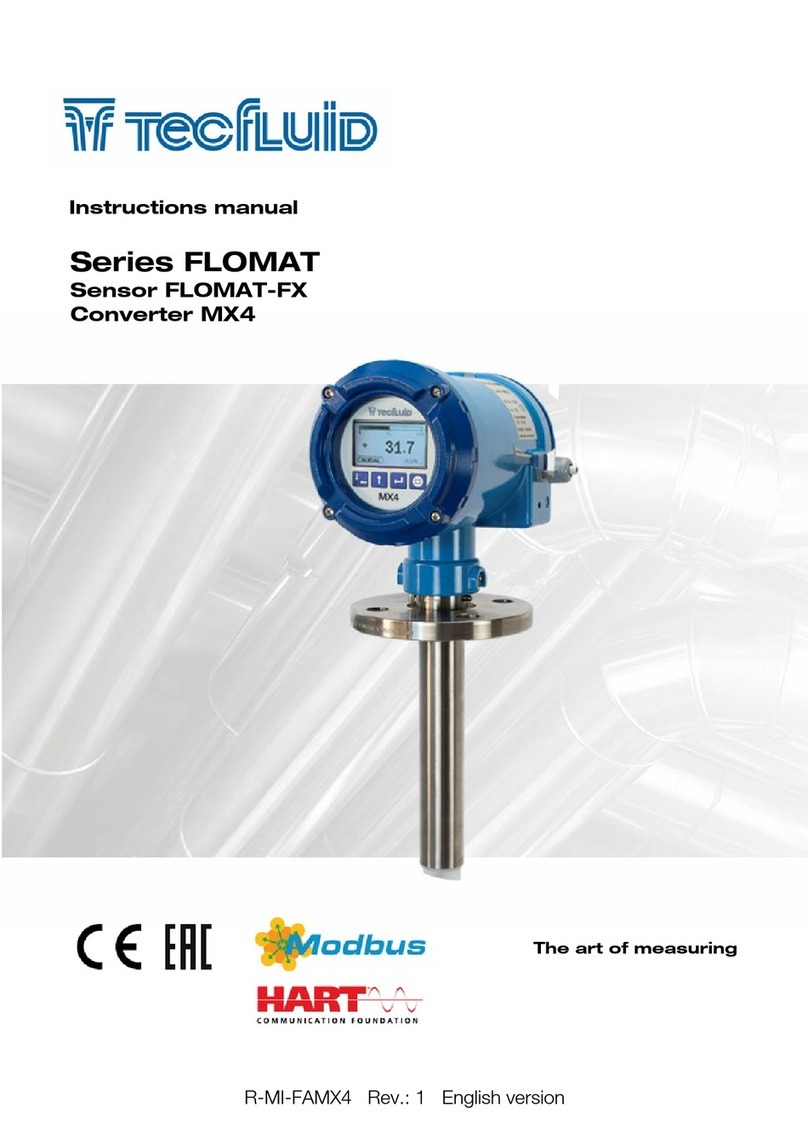
Tecfluid
Tecfluid FLOMAT Series User manual
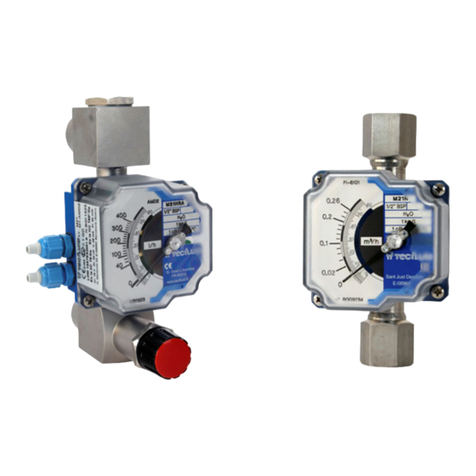
Tecfluid
Tecfluid M21 User manual
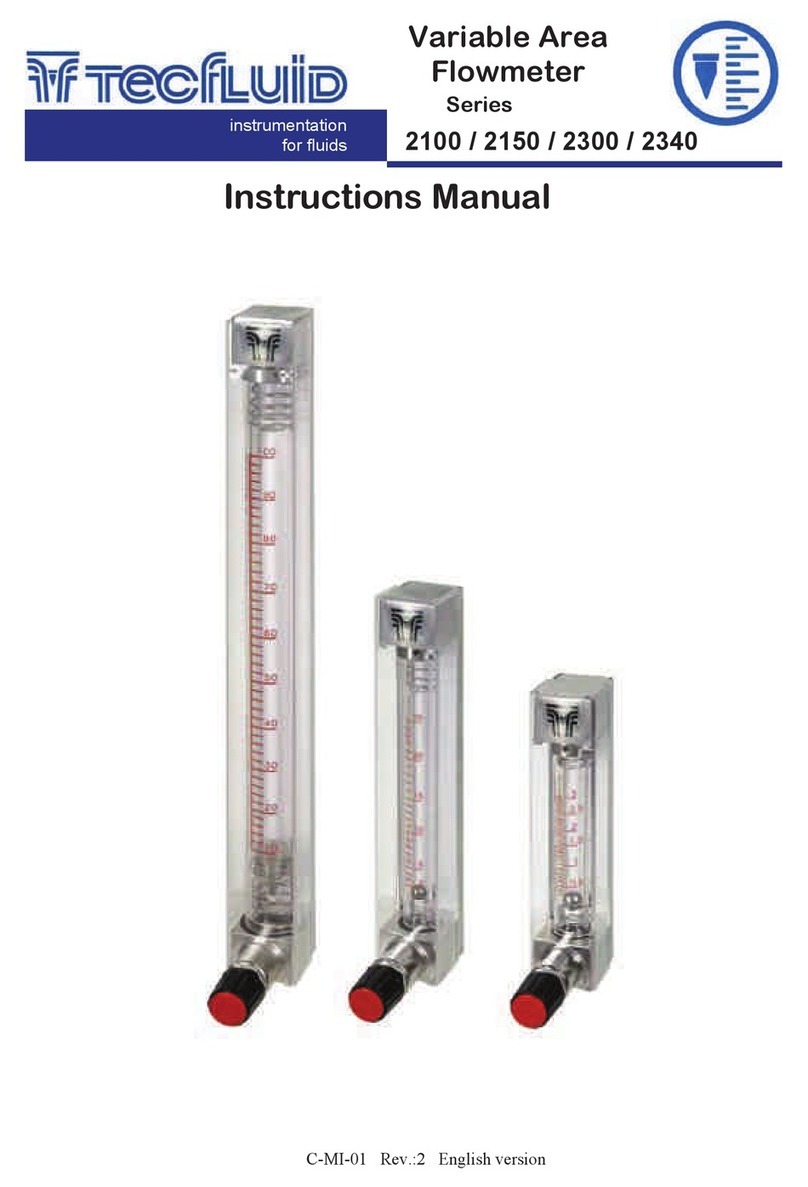
Tecfluid
Tecfluid 2100 Series User manual

Tecfluid
Tecfluid LS Series User manual

Tecfluid
Tecfluid CU Series User manual
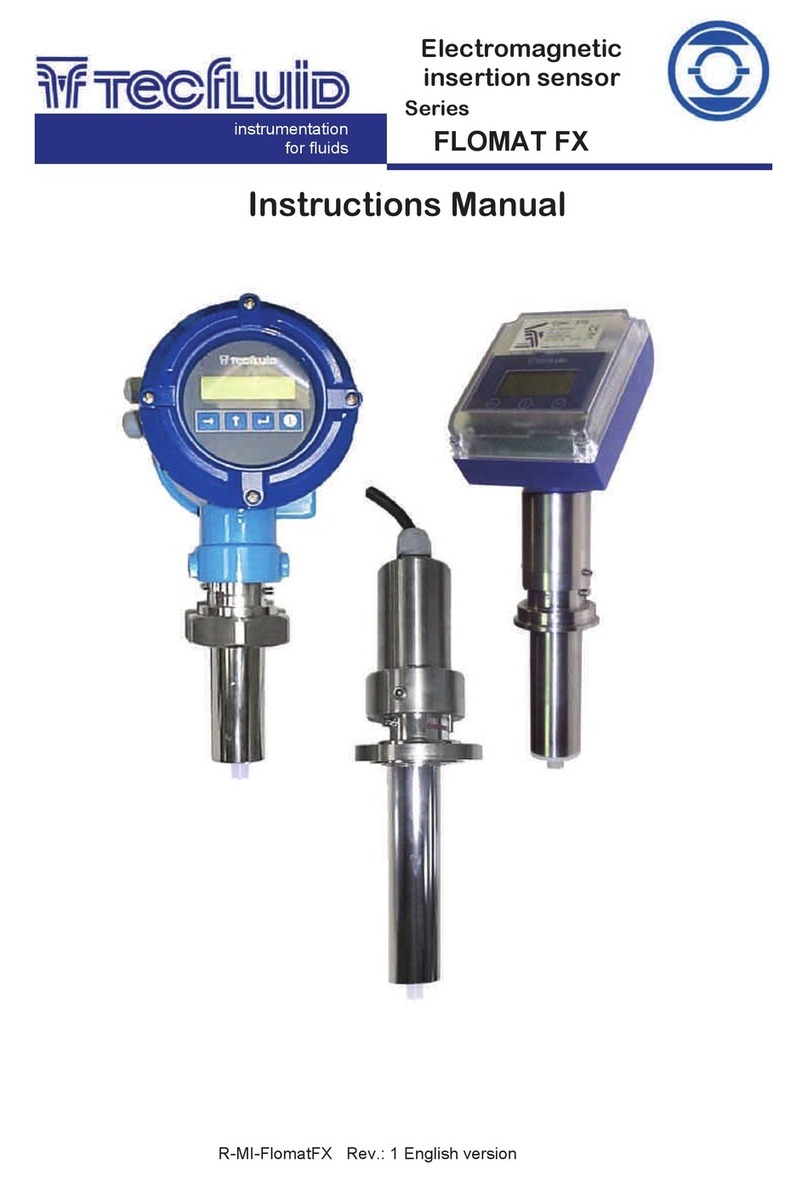
Tecfluid
Tecfluid FLOMAT FX FlomatFX User manual
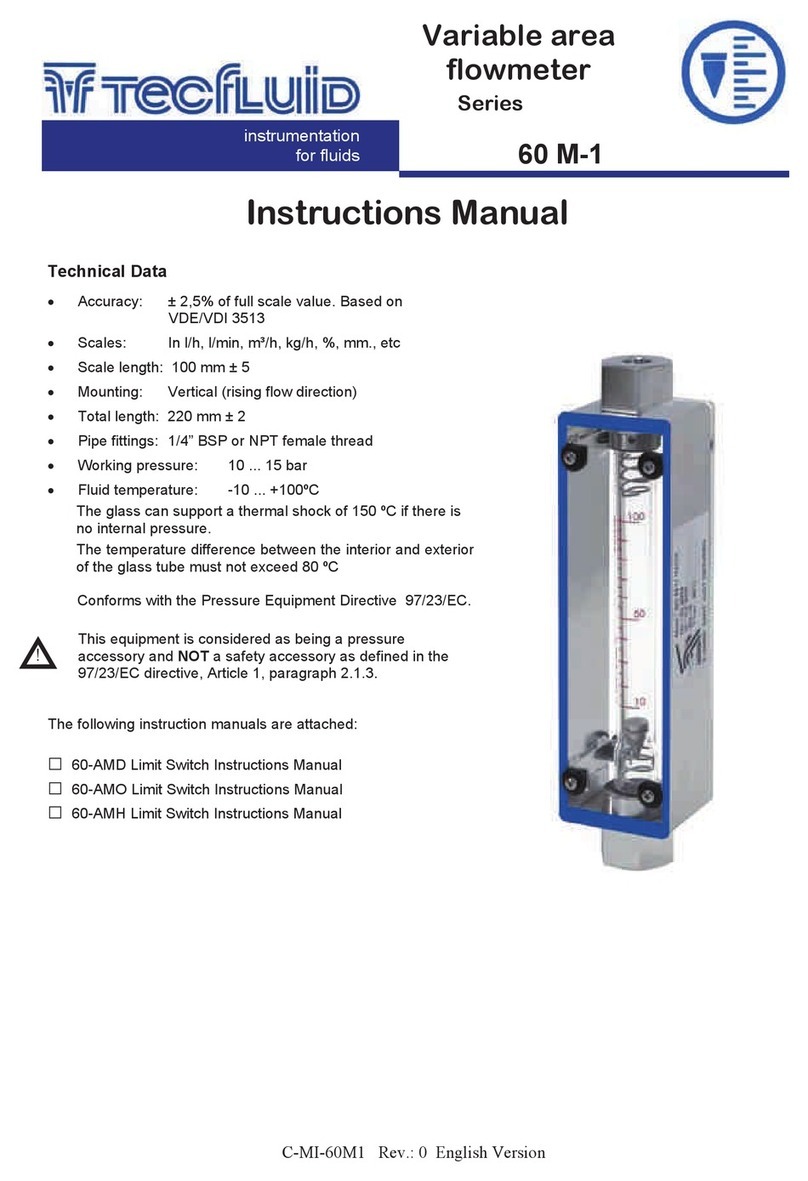
Tecfluid
Tecfluid 60 M-1 Series User manual
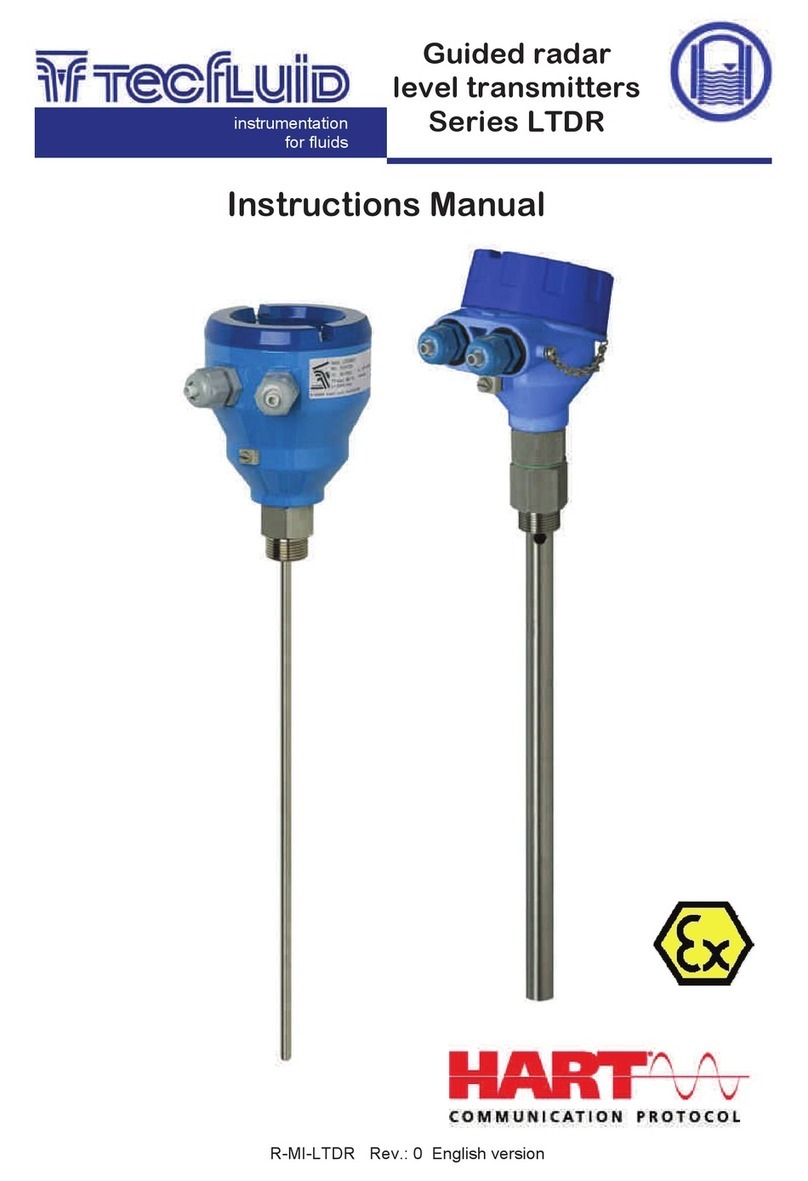
Tecfluid
Tecfluid LTDR series User manual



